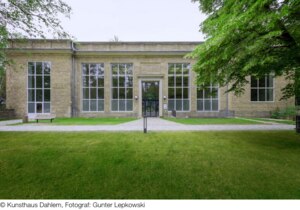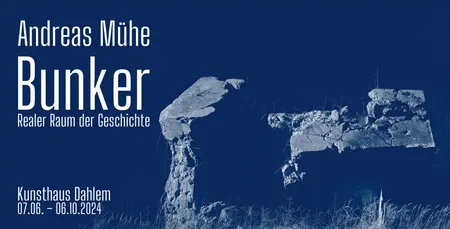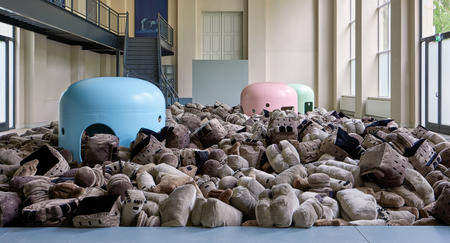Andreas Mühe. Bunker
Real Historical Space
I would hunt these gray forms until they would transmit to me a part of their mystery.
Paul Virilio: Bunker Archeology, 1975
Bunkers pervade Europe’s landscape as monumental forms of concrete, from Germany to Brittany in France and the English Channel, but especially along the coast of the Atlantic from Norway to the Spanish border. In Italy, Austria, Germany and many other countries, bunkers are still found in city centres today as oversized, indestructible structures. The National Socialists called their bunker construction project “Fortress Europe”. They built a fort of dictatorship. Their dark past is permanently inscribed into the bunkers.
The artist Andreas Mühe, who traced these strange structures on many travels along the so-called “Atlantic Wall”, takes the metaphorical potential of the bunkers as the central starting point for an ambitious installation. It is the first sculptural work of the artist known for his precisely constructed photographs. Mühe intensifies the transformation of the bunker to the greatest possible extent: he reduces the monumental dimensions of the hard concrete architectures to a humanly comprehensible size and transforms them into small, soft objects – like the stuffed animals that children play with. In place of a singular monument, Mühe allows many small “fabric bunkers” to arise, a sea of bunkers, as it were, which floods the exhibition space. Mühe has consciously decided in favour of a democratic, an approachable, large quantity instead of a single monolith dominating everything. In place of the heavy, monumental materiality and impact of the bunker, one encounters the soft surface feel of the easy to manage miniature version. Through this contradiction, the artist invites us to question and thoroughly examine bunkers – their architecture, impact and history: what function do bunkers have today in the city, but also along the Atlantic coast? What becomes of the buildings when they are used as party locations or band rehearsal spaces, as a loft or for the cultivation of mushrooms? Upon what phantasms is our conception of bunkers as a protective space based? In the face of the present-day technology of war and weaponry, can there even be such a thing as a constructed protective space? To what extent is history inscribed into the materiality of the concrete, and, conversely, how does the inherent iconography of the concrete incorporate itself into history?
Further central artistic positions of past years and decades are found In another exhibition space, in which bunkers have been thematically addressed with a view to their materiality, historicity and social significance. The central stimulation for this artistic practice was the book “Bunker Archeology” of the French cultural philosopher Paul Virilio, which appeared in 1975. Joachim Bandau, for example, involved himself with the theme early on. Initially in drawings and also subsequently in three-dimensional objects, for example, sculptural studies in lead, he pointed out the diversity of forms in relation to a typological cycle of architectural basic forms. In the photos of Hubert Kiecol, we can then see sculptures aimed at providing these forms with large dimensions despite their small scale. Through the material concrete, these forms, standing directly and without plinths on the floor, have an expansive presence and are more than mere small forms. Finally, Erasmus Schröter stages bunkers and bunker ruins by shining coloured light on them. The monotonous concrete is in this way superimposed with colour compositions that seem like alienations of usage and purpose. The once so violent testimonials to human feelings of superiority here lie in ruins, are today more scenery than an object for use.
///
With works by Andreas Mühe as well as Joachim Bandau, Göksu Baysal, Barbara Klemm, Hubert Kiecol, Wilhelm Klotzek, Tobias Kruse, Konrad Mühe, Erasmus Schröter, Paul Virilio and the designer Ursula Wünsch.


